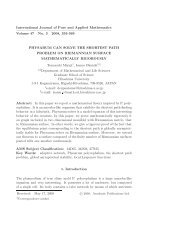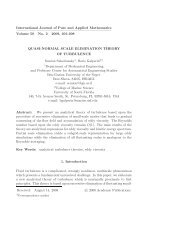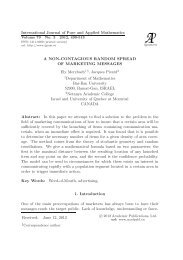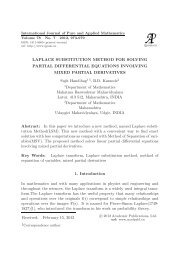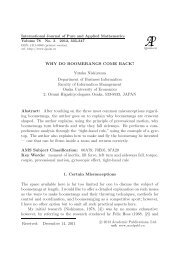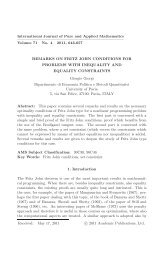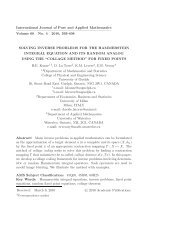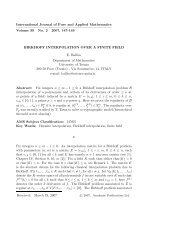FINDING N-TH ROOTS IN NILPOTENT GROUPS AND ...
FINDING N-TH ROOTS IN NILPOTENT GROUPS AND ...
FINDING N-TH ROOTS IN NILPOTENT GROUPS AND ...
You also want an ePaper? Increase the reach of your titles
YUMPU automatically turns print PDFs into web optimized ePapers that Google loves.
<strong>F<strong>IN</strong>D<strong>IN</strong>G</strong> N-<strong>TH</strong> <strong>ROOTS</strong> <strong>IN</strong> <strong>NILPOTENT</strong> <strong>GROUPS</strong>... 591<br />
they both agree on a key. The security of this scheme lies on the difficulty of<br />
finding square roots in 2-Engel groups. (see [7] for more information about this<br />
part.)<br />
One could extend this scheme to other n-Engel groups, since there are<br />
similar relations in them as well (see [17]).<br />
9.2. A Digital Signature Based on 4-Engel Groups<br />
Consider a 4-Engel group, which is nilpotent and satisfies the following semigroup<br />
law:<br />
xy 2 xyx 2 y 2 x 2 yxy 2 xyx 2 yxy 2 x 2 y 2 xyx 2 y = yx 2 yxy 2 x 2 y 2 xyx 2 yxy 2 xyx 2 y 2 x 2 yxy 2 x<br />
The idea to make a digital signature is as follows: Suppose x and y are<br />
secret and x 2 , y 2 , xy 2 x and xy 2 x 2 y 2 x public information.<br />
The public key is x 2 and the signature is the tuple of xy 2 x and xy 2 x 2 y 2 x.<br />
The verifier knows y, so he only needs to verify both of the semigroup identity.<br />
The security of this digital signature lies on the fact that the complexity of<br />
finding square root in a 4-Engel group is experimentally proved to be exponential.<br />
The Hirsch length of a 4−Engel group could even be 88 and nilpotent of<br />
class 9 (see Werner Nickel’s webpage and [12]) and by the best known algorithm<br />
by Nickel, we know that the complexity of finding matrix representations in a<br />
nilpotent group of class 9 and Hirsch length 88 is exponential; which ultimately<br />
gives us a solution to finding a square root in the underlying 4-engel group.<br />
Acknowledgments<br />
The authors are grateful to Professor Michael Anshel for helpful discussion<br />
in the early stage of this project. The authors also thank Professor Gilbert<br />
Baumslag for his useful comments. Delaram Kahrobaei, would like to thank<br />
Professor Derek Holt for his helpful comments during her visit to Warwick University.<br />
The research of Delaram Kahrobaei has been supported by a grant from<br />
the City Tech Foundation and PSC CUNY Research Foundation of CUNY. The<br />
research of Makenson and Renald has been supported by City Tech Foundation<br />
and NSF-AMP.



